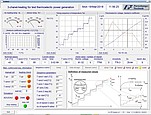Investigation of the thermoelectric effect


Description
For some years now, the institute has been carrying out investigations in which the thermoelectric effect in special polymer structures could be demonstrated in principle using an initially simple measurement setup. This effect was first described in 1823 by the German physicist THOMAS JOHANN SEEBECK. Based on this, the task now was to build up a test facility with which more precise and targeted investigations can be carried out on strip-shaped polymer test objects. Since the effects to be expected are very small, special requirements were placed on the facility. For example, the experimental room with the test object should be shielded from environmental influences and meet certain conditions (low humidity, temperature constancy during the measurement, etc.). As a result, a system was developed in which test objects can be clamped between two separately heatable copper plates in a closed cylindrical volume that can be heated and filled with inert gas. The measuring chamber and the two copper plates are heated via three independent controllable heating circuits with a temperature constancy of less than 1 K for each heating circuit. Between the two plates, the thermoelectric voltage falling across the measured object is measured. The system is controlled by a computer program which enables a fully automatic test sequence including data storage and evaluation up to the calculation of a temperature-dependent Seebeck coefficient for the test object
Technical Data
Mechanical construction: In-house development IPF
Control electronics: Development and construction Firma Wünschmann Mess- und Regeltechnik OHG
Software: Agilent VEE Applikation
Contact person

